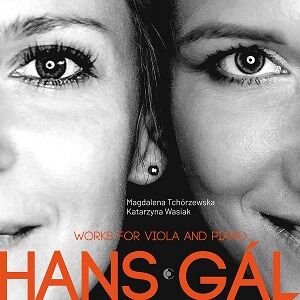
Hans Gál (1890-1987)
Sonata for viola and piano, Op.101 (1942)
Impromptu for viola and piano (1940)
Suite for viola and piano, Op.102a (1949)
Magdalena Tchórzewska (viola)
Katarzyna Wasiak (piano)
rec. 2019, Aula Nova Hall, Ignacy Jan Paderewski Academy of Music, Poznań, Poland
RecArt 0045 [41]
In getting to grips with Hans Gál’s music, one must know of his conservative aesthetic: there are influences of Brahms and, somewhat less, of Mahler, but no traces of the avant-garde and even of the strictures of Schoenbergian dodecaphonic techniques. The current online edition of Grove’s Dictionary sums it up well. His style unites “many elements: the clarity, playful humour and formal mastery of early Classicism; the chromatic harmony and extended tonality of early 20th-century, pre-serial music; a Schubertian love of melody; the lyricism and emotional restraint of Brahms and the contrapuntal textures that remained fundamental to his style.”
Margaret Moncrieff Kelly’s outstanding Personal Tribute and Memoir introduces Hans Gál in detail. For a biographical sketch, see my review of his Music for Voices, Volume 2.
The Viola Sonata is a major work by any standards. It opens with a thoughtful Adagio which traverses some deeply felt emotions. This surely reflects the challenging times Gál was experiencing in 1942. His mother died after being badly injured in a road accident. Equally traumatic was the death of his sister Edith and his aunt Jenny, who had remained in Germany and now committed suicide to avoid deportation to the concentration camps.
The second movement is a parody of a Viennese waltz, with a certain amount of humour, but the rapt “trio” section reverts to deeper thoughts. The finale is a march beginning with a restless theme in A minor, transformed in several ways before it slows down and is reprised one last time in the major key. Overall, this beautifully devised sonata seems to look beyond Gál’s painful personal circumstances. Although there is much brooding, the overall effect is optimism rather than angst or resentment.
The beautiful Impromptu, deliciously retro, was dedicated to Gál’s young son Peter, who had recently taken up the viola. The liner notes remind us that the composer understood “impromptu” as “spontaneous invention”. It does have the freedom of expression that this implies. This present from father to son probably coincided with a term break from the lad’s boarding school. Gál’s daughter Eva Fox-Gál suggests that the pair of them would have played it together. Nothing complicated, just romantic, Brahmsian and emotionally plangent. It should be in the repertoire of all violists, and would make a moving encore.
The Suite for viola and piano has several incarnations. It was first written for the virtuoso Dutch saxophonist Jules de Vries, and scored for alto saxophone and orchestra. It received its premiere in Borås, Sweden as Suite Concertante. The liner notes explain that at the back of Gál’s mind the piece was from the start envisaged for viola and piano. Apparently, he performed it in this format in Edinburgh in 1951. The Suite has four movements. The opening “cantabile” is an intimate dialogue between instruments, lugubrious and ruminative. It leads into a furious dance, acerbic if not too dissonant. A gently unfolding minuet continues the mood of soul-searching, even harking back to Elgar. The finale Burla is a rondo whose rumbustious refrain contrasts with expressive episodes. The work ends with a dramatic cadenza.
The informative booklet (in Polish, English and German) outlines Hans Gál’s life and times. There follows an appreciation of the composer by pianist Katarzyna Wasiak, and biographies of the performers. The last, most important section is an interview with Eva Fox-Gál. Its question/answer format offers a considerable insight into the works recorded on this disc.
The Viola Sonata and the orchestral version of the Suite appear in the first volume of Toccata Classics’ survey of Gál’s viola music, played by violist Hanna Pakkala and pianist Irina Zahharenkova (review). There are several other recordings of the works on this disc.
I enjoyed this release, absorbing from the first bar to the last. More important, it moved me. The performances balance the humour, the warmth, the lyricism and the introspection of these appealing works. They are complimented by an excellent recording and informative documentation.
John France
Help us financially by purchasing from



















